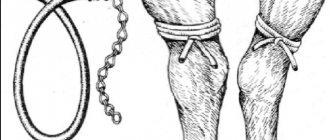Causes of hematuria
The presence of blood in an animal's urine can be caused by:
- Trauma.
Damage to bladder or kidney tissue caused by a street fight or accident requires immediate medical attention. Hematuria in such cases is usually accompanied by pronounced pain symptoms: the dog whines, has trouble standing on his feet, hunches over, and tries to lie down. - Poisoning.
If a dog has eaten rat poison or another toxic substance other than blood in the urine, it will experience vomiting, diarrhea, watery eyes, and mucous discharge from the nose. This condition is also an emergency and requires urgent medical attention. - Cystitis .
Characteristic signs of bladder inflammation caused by hypothermia or bacteria entering it through the urethra are pain and frequent urination. The urine is cloudy and contains blood and protein flakes. - Urolithiasis.
If a dog experiences pain when emptying its bladder, and there is scarlet blood in the urine, it is most likely due to urinary stones - urates. When displaced, these stones damage the tissue of the kidneys and urinary organs, causing bleeding.
- Diseases of the genital organs
. In males, hematuria is most often caused by diseases of the prostate gland, in females - by ovarian cyst or pyometra. Such pathologies are accompanied by pain, elevated body temperature, lack of appetite, and general malaise: the dog loses activity, refuses to walk, and sleeps a lot.
- Glomerulonephritis
. This inflammatory disease that affects the glomeruli of the kidneys provokes a change in the color of urine to reddish, and is accompanied by edema, severe thirst, vomiting, and general weakness. - Parasitic diseases.
Often, bloody urine in a dog is detected due to parasitic diseases, as they cause the destruction of blood elements - red blood cells and the release of their coloring substance - hemoglobin - into the urine. Associated symptoms in this case will be paleness of the mucous membranes, atony, general exhaustion, bowel disorders (alternating diarrhea and constipation), and sometimes fever. - Malignant neoplasms.
A general serious condition and blood in the urine are almost always observed in the last stages of cancer of internal organs.
Good to know. The urine of a completely healthy dog can have a brownish or reddish color. If your pet is active, eats well, and does not look sick, it is quite possible that the cause of the atypical urine color is eating foods containing plant pigments (beets, carrots) or taking medications that cause changes in the color of urine and feces.
What should the owner do?
If the appearance of red blood cells in a pet’s urine is the only clinical sign that worries the owner, the animal’s general health does not cause serious concern and there is no need to panic. Perhaps the pet’s disease is in its early stages, the situation is not critical. Careful observation of the pet's behavior and condition will be required.
Observe how your dog behaves during urination. Signs monitored:
- Liquid color and quantity, presence of impurities in the form of streaks of blood and mucus or uniform coloring.
- Dog posture when urinating.
- The presence of external signs that the animal is in pain - whining, restlessness, attempts to rub its butt on the floor.
- Frequency of episodes of hematuria.
- The time of onset of symptoms is in the morning or evening, connection with food intake.
- Can the animal control itself during urination or does it leave puddles in inappropriate places?
- Is there bleeding outside of urination?
- When the impurity appears - at the beginning of urination or at the end.
You should not try to treat yourself using special medications. If the appearance of blood in the urine is accompanied by other symptoms of the disease, seek medical help immediately, as the clock may be ticking.
Diagnostics
If you notice that your dog's urine is brownish or, worse, scarlet in color, a visit to the veterinarian is required. But to make a correct diagnosis, anamnesis data are important, in particular:
- The amount of urine and the frequency of emptying the bladder (in some diseases the bladder does not empty completely).
- The animal’s posture and behavior when urinating (if a dog experiences pain when trying to urinate, it sits low and whines).
- Is the discharge of blood due to its presence in the urine, or is it possible that the urine is mixed with bloody discharge from the genitals.
- What changes in behavior and symptoms of illness does the dog have - fever, lethargy, loss of appetite, digestive disorders.
After a visual examination and studying the history provided by the animal owner, the veterinarian will most likely prescribe a number of laboratory and instrumental examinations for your pet. First of all, this is a urine test. Before collecting urine for analysis, it is recommended to ensure the cleanliness of the dog’s external genitalia - wash them with warm water and/or treat them with an antiseptic solution. According to the rules, an average portion of urine is taken, approximately 1-2 seconds after the start of urination. If necessary, if self-sampling of urine is not possible, the doctor can collect it with a catheter.
Important! It is not always possible to determine the presence of blood in a dog’s urine visually, since most often the animal relieves itself on the street, while walking. Therefore, it is so important to undergo routine examinations of dogs in a timely manner, during which a urine test is performed.
In addition, for differentiated diagnosis of the causes of hematuria, it may be necessary to conduct a blood test - clinical or biochemical, as well as an ultrasound or x-ray examination of internal organs.
What examinations are carried out
To understand what is happening to the pet, the reason that caused the appearance of blood impurities in the urine is determined. For this purpose, go to the doctor and undergo examinations:
- General urine analysis - signs of the inflammatory process are determined, the appearance of leukocytes and red blood cells in the biological fluid.
- Complete blood count – monitors for signs of inflammation and anemia.
- Biochemical analysis for the content of total protein, creatinine, uric acid.
- Ultrasound examination of the kidneys and bladder.
- X-ray examination of the abdominal cavity.
Based on the results of the examination, the veterinarian will determine whether the dog has a disease or whether the coloring is related to the food eaten. Hematuria must be differentiated from hemoglobinuria, which develops under the influence of hemolytic poisons. For differential diagnosis, microscopy of the pet's urinary sediment is performed.
Treatment
Therapeutic measures are prescribed depending on the type of disease that caused hematuria. In case of poisoning, the dog is given a gastric lavage and a course of detoxification therapy is prescribed, as well as medications to maintain the functioning of the organs.
To treat cystitis, which in dogs in 90% of cases is of bacterial origin, antibiotics are usually prescribed:
- Amoxicillin.
- Baytril.
- Ceftriaxone.
Antimicrobial drugs Nitroxoline, Furagin, Furadonin are also used. After a course of antibiotic therapy, to normalize the state of the intestinal microflora, it is recommended to use bifalact.
If hematuria is caused by helminths or exoparasites, the doctor will prescribe medications for the dog that suppress the development of parasitic organisms. The most popular in veterinary medicine are:
- NexGard Spectra is a remedy for helminths, fleas and ticks, the active ingredients are afoxolaner and milbemycin oxime.
- Fort Dodge Kanikquantel plus is an anthelmintic, the active ingredients are praziquantel and fenbendazole.
- Milprazone is an antiparasitic agent containing praziquantel and milbemycin oxime.
When infected with blood parasites that cause amebiosis, piroplasmosis, trichomonas urovaginitis, antiprotozoal agents based on imidocarb dipropionate are used: Ornidazole or Piro-stop, as well as drugs for general support of the body.
Treatment of glomerulonephritis in dogs includes taking glucocorticosteroids, drugs to correct pathological changes in the composition of blood proteins, and if streptococci are detected in the body, prescribing antibiotics, to which these facultative anaerobic microorganisms are sensitive.
If the cause of blood in urine is a malignant tumor, it is usually treated surgically. Non-invasive therapy can be effective only in the initial stages of the disease.
Answer
If you notice while walking that your dog has reddish or brown impurities in its urine, this is a symptom of the pet’s poor health. Blood in the urine is called hematuria. There are many different reasons given for its occurrence. Some pose a threat to the health and life of the animal. This symptom should not be treated with disdain.
If blood elements are present in the urine, the liquid acquires a characteristic reddish tint. Blood in the urine should be distinguished from the appearance of spots during estrus or discharge from the rectum. More often, traces are found on the litter where the animal rests.
Prevention
To reduce the risk of your dog developing hematuria, you should adhere to the following rules:
- do not let your dog go for a walk unaccompanied, as he may get hit by a car or get injured in a street fight;
- do not allow your pet to come into contact with strangers, especially stray dogs, which may show aggression or be carriers of dangerous infections;
- To strengthen the immune system, provide the dog with adequate nutrition and introduce vitamin and mineral supplements into the diet.
The most important method of preventing diseases associated with urine is to try to control the appearance of urine when walking your dog, and if there are suspicious signs, immediately contact a veterinarian. A disease detected at an early stage is much easier and faster to cure, even if it is a rather dangerous pathology.
What to do if your dog is peeing blood
What to do if your dog has bloody urine? to take any measures to eliminate the disease without test results . For an accurate diagnosis, the doctor should provide the following indicators:
- urine color;
- characteristics of urination (in what position it occurs, regularity, amount of liquid, pressure);
- the presence of painful sensations;
- incontinence;
- presence of blood between urinations;
- possible relapses of diseases;
- noticeable changes in the pet’s condition.
After the urine test, the dog should undergo an ultrasound or fluoroscopy . To do this, before diagnosing, it is necessary to give the animal plenty to drink so that the bladder is full.
To the question whether it is possible to get by with home treatment, the answer is a categorical no . The presence of blood most often manifests itself due to serious illnesses, and self-medication can only worsen the dog’s condition and lead to various consequences.
Share
Leave a review
Norm and stages
It is necessary to pay attention to the exact moment it appears and its quantity - this will help in making a diagnosis.
Normally, urine is straw-yellow in color, without impurities, and transparent.
With hematuria, the urine is not necessarily red-scarlet. It takes on the following shade:
- red
- pink
- red-brown (resembling tomato juice)
- red-orange
- orange
Reasons why blood appears in urine
1. Piroplasmosis. This is a deadly blood parasitic disease that is transmitted by a tick bite. Contrary to popular belief, a tick can bite a dog even in a city where there is little dry grass and trees. Therefore, it is necessary to treat your pet for ectoparasites from March to November.
One of the main characteristic symptoms of piroplasmosis is the presence of blood in the urine. Moreover, in advanced stages, the color of urine itself may change to red-brown. Why is this happening? Pyroplasmas, entering the dog’s body, begin to destroy blood cells, causing anemia. The animal's kidneys are unable to filter out the destroyed red blood cells, so the urine turns various shades of red.
If you notice blood in the urine of a puppy or adult dog, as well as lethargy, high fever, refusal to eat, or weakness of the hind legs, do not self-medicate and waste time, consult a veterinarian. This disease develops at lightning speed, so delay will cost your pet’s life. But if treatment is started on time, complications will be minimal. As a rule, it is necessary to administer an antidote and conduct a course of IV drips that relieve intoxication. In severe cases, a blood transfusion may be required.
2. Leptospirosis. The infectious disease leptospirosis is caused by bacteria of the genus Leptospira. This disease is dangerous not only for dogs, but also for humans. It is characterized by damage to the capillaries of blood vessels, as well as the kidneys and liver. With leptospirosis, severe general intoxication of the body occurs. A striking symptom is the appearance of blood in the urine, as well as fever, refusal to eat and yellowness of the mucous membranes. Animals that bathe in stagnant bodies of water, as well as hunting dogs, are at risk, but the risk of disease in unvaccinated dogs and in urban environments cannot be excluded.
Leptospira is transmitted when contaminated urine comes into contact with damaged skin or mucous membranes. A dog only needs to sniff the mark of a sick dog or drink from a puddle to become ill.
This disease is curable if you do not waste time, but leptospirosis must be differentiated from piroplasmosis and only a veterinarian can do this competently, after conducting an examination and the necessary tests. You can make a diagnosis by passing virological tests.
3. Cystitis. A male dog may have blood in his urine during cystitis, which appears due to an ascending infection, if the dog takes a long time to go to the toilet. Because inflammation of the bladder is a common pathology not only in humans, but also in animals. Symptoms include frequent urination in small portions, and blood may drip at the end or evenly discolor the urine. Also, inflammation of the mucous membrane of the bladder can be idiopathic, that is, when the cause is psychogenic factors - severe stress, for example, due to the departure of the owner. It is important to determine the cause of cystitis - only in this way can it be cured quickly and effectively.
4. Urolithiasis. The causes of urolithiasis are impaired metabolism, low water consumption and improper feeding of the dog. In this case, the disease can appear in both an adult and a young animal, and most often without obvious dependence on the general health of the body. Sand can form in the kidneys, gradually forming into stones. This injures the renal pelvis and bladder, causing blood to appear. Often, with urolithiasis, cystitis develops as a concomitant disease due to constant trauma to the mucous membrane.
Stones are divided into soluble and insoluble. To determine which stones your pet has, you need to take a urine test. In the first case, subject to a special diet and general treatment, the dissolution of salts occurs within several months. If the stones are of the insoluble type, surgical removal is necessary. Otherwise, you will face a series of endless cystitis, and the worst case scenario is blockage of the urethra with stones and the inability to urinate.
5. Polyp in the bladder. A bladder polyp usually does not cause any discomfort to the dog, but it can frighten the owner with the periodic appearance of blood in the urine, which goes away on its own and appears again after some time. The presence of a polyp can be determined by ultrasound diagnostics; if necessary, the polyp is removed.
6. Jade. Inflammation of the parenchymal renal tissue can be accompanied not only by urination with blood, but also by high fever, general weakness, and refusal to eat. Acute nephritis develops due to an ascending infection if cystitis has not been cured or there is some other source of inflammation in the body. Chronic nephritis is characterized by the periodic appearance of blood in the urine when the general condition of the animal is good. In the future, this can lead to chronic renal failure, which is why it is so important to identify the presence of nephritis in time and begin treatment.
7. Heat. Found blood clots in your urine? If you are the owner of a female dog, your dog may simply be in heat. These animals are characterized by heavy bleeding during estrus. It may be worth remembering when the previous estrus was, or better yet, visit a veterinarian who can take a swab from the dog’s loop and more accurately tell the reason for the appearance of blood and determine whether the estrus is normal or if it is a pathological discharge.
8. Pyometra / Endometritis. But inflammation of the uterus, including purulent inflammation, can lead not only to the appearance of blood in the dog’s urine, but also to poor health of the animal as a whole. If you have an unspayed female dog who is periodically given hormonal medications to suppress her heat, and she has recently started urinating blood, there is a good chance she has endometritis. Do not delay - when a large amount of purulent content accumulates in the uterus, it may rupture and peritonitis may occur. For such inflammation, only surgical treatment is effective.
The dog is vomiting and has blood in its urine. Dog peeing blood: why and how to treat
Normal urine in dogs is straw-yellow in color and has no distinct odor. If the color of the discharge changes, this may indicate that there is a pathology in the body. Dark mustard color of urine indicates dehydration, and orange color indicates liver or gallbladder disease. Urine that is too dark, brown or almost black, may indicate the presence of a malignant tumor. Discharge with blood, in turn, is a symptom of various disorders that may pose a danger.










